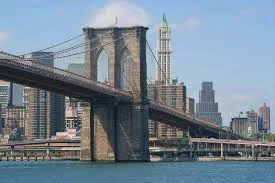Connecting Histories, Shaping Futures—The Story of New York's Most Iconic Bridge.
Introduction
Standing as one of the most recognized symbols of New York City, the Brooklyn Bridge is not just a feat of 19th-century engineering, but a living piece of American history. Spanning the East River to connect the boroughs of Manhattan and Brooklyn, the bridge represents ingenuity, perseverance, and the unrelenting spirit of progress. For more than a century, it has inspired artists, filmmakers, architects, and tourists alike, becoming an enduring emblem of connection and urban evolution.
The Vision Behind the Bridge
In the mid-1800s, New York City was rapidly growing, and the need for a reliable connection between the commercial heart of Manhattan and the burgeoning population of Brooklyn became evident. Ferries were the main mode of transportation across the East River, but they were often unreliable, especially in winter.
Enter John Augustus Roebling, a German immigrant and renowned civil engineer. He envisioned a suspension bridge of unprecedented length and strength—a structure that would not only connect two boroughs but would stand as a marvel of engineering. In 1867, after years of lobbying and engineering studies, the New York State Legislature approved the construction of the bridge.
A Bridge Born of Struggle and Innovation
Tragically, John Roebling never saw his vision realized. He died in 1869 from tetanus following a construction-related accident. His son, Washington Roebling, took over the project and carried the weight of his father’s legacy. However, Washington himself was soon afflicted with caisson disease (commonly known as “the bends”) due to his time spent in the compressed-air underwater chambers used to build the bridge’s foundations.
Despite being bedridden for much of the construction, Washington Roebling continued to direct the project with the help of his wife, Emily Warren Roebling. Emily played a critical role, becoming the de facto chief engineer. She learned engineering principles, oversaw daily operations, and served as the communication link between her husband and the workforce. Her contribution is now widely acknowledged as essential to the bridge’s completion.
Engineering Feats and Design
The Brooklyn Bridge was a marvel of its time. When completed in 1883, it was the longest suspension bridge in the world, with a main span of 1,595.5 feet (486.3 meters). Its two Neo-Gothic stone towers, rising 276 feet (84 meters) above the river, were constructed with limestone, granite, and Rosendale cement. They anchor the bridge’s massive steel cables—each consisting of 5,434 individual wires.
The bridge introduced several engineering innovations, including the use of steel-wire cables, which had never been used in bridge construction before. It also utilized a hybrid cable-stayed/suspension design, adding extra stability and load-bearing capacity.
Its promenade—a wooden walkway elevated above the road—was another novelty, giving pedestrians a scenic view of the river and the city, long before the idea of urban walking paths became common.
Grand Opening and Public Reception
On May 24, 1883, the Brooklyn Bridge opened to the public in a grand ceremony attended by thousands, including President Chester A. Arthur and New York Governor Grover Cleveland. Emily Roebling was the first to cross the bridge, symbolically carrying a rooster as a sign of victory.
The bridge quickly became an essential transit link, carrying horse-drawn carriages, trolleys, and eventually automobiles. It also became a cultural icon, featured in poems, paintings, and later, in films and photography.
Cultural Impact and Symbolism
More than just a transportation route, the Brooklyn Bridge became a symbol of hope and determination. It epitomized the idea of overcoming adversity—through its difficult construction, personal sacrifices, and groundbreaking innovations. It remains a powerful metaphor for human connection, bridging not only two land masses but also diverse communities and ideas.
Writers like Walt Whitman and Hart Crane (whose poem “The Bridge” is a modernist epic) immortalized the bridge in literature. Painters of the American modernist era, such as Joseph Stella, used it as a recurring subject. In cinema, the bridge has been featured in countless films, from thrillers to romantic comedies, solidifying its place in global popular culture.
Modern Use and Preservation
Today, more than 120,000 vehicles, 30,000 pedestrians, and 4,000 cyclists cross the Brooklyn Bridge every day. Despite its age, it continues to function as a vital artery in New York’s transportation network.
Efforts have been made to preserve and restore the bridge without compromising its historical integrity. In 1964, it was designated a National Historic Landmark, and in 1972, it was added to the National Register of Historic Places. Regular maintenance, including the restoration of its pedestrian promenade and the addition of bike lanes, has helped modernize the bridge while honoring its legacy.
Conclusion: A Testament to Time and Tenacity
The Brooklyn Bridge is far more than a crossing over water. It is a testament to vision, resilience, and the unbreakable human spirit. Its towers and cables continue to watch over the city, reminding us of a time when the impossible was made possible.
Whether you’re a tourist admiring the skyline, a commuter traveling between boroughs, or a history enthusiast tracing the footsteps of the Roeblings, the Brooklyn Bridge remains a living monument—linking the past, present, and future in one of the world’s most dynamic cities.











.jpeg)


0 Comments